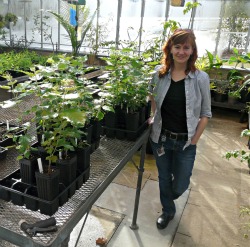
'A tremendous time to be a researcher here'
 Watch the new video on Connecticut College's YouTube channel.
Watch the new video on Connecticut College's YouTube channel.
In 1917, botany professor Caroline Black made a deal. She would accept a position at Connecticut College and chair the botany department on one condition: botany must remain separate from biology. With this simple agreement, Connecticut College made a commitment to plant science that continues to this day.
While many other colleges have merged their botany and biology programs, they remain distinct at Connecticut College. Undergraduates in the botany program have unparalleled opportunities for research with faculty, access to unique plant collections and a 3,000-square-foot greenhouse for experiments and observation. The botany professors are some of the world's leading plant scientists, and the botany program, with courses in areas as diverse as ethnobotany (the cultural use of plants) and wetland ecology, has an international reputation for excellence.
In 2011, the College's Centennial year, the storied botany program will begin a new chapter with the groundbreaking of the College's more than $20-million renovation and addition to New London Hall to create a state-of-the-art home for the life sciences (botany and biology) and computer science. The historic greenhouse will get a makeover as part of the renovation.
"It's a tremendous time to be a plant researcher here, and a student interested in plant biology," Botany Professor Rachel Spicer (pictured above) says in a new video on the College's YouTube channel. "As a prospective faculty member, I was immediately drawn to Connecticut College by the commitment to plant biology. And to have access to a plant collection like this [and] greenhouse facilities for both teaching and research -- it's really unprecedented for a small liberal arts college."
Built in 1935 with a grant from the Rockefeller Foundation, the greenhouse is an important teaching and research facility for botany and ecology classes.
"The work in the greenhouse helps support [our] research endeavors by providing controlled environments for plants to grow, either just as their native living conditions or under experimental conditions," T. Page Owen, chair of the botany department, says.
The renovation plan for the greenhouse retains its character and layout, but updates systems for everything from regulating sunlight to moving water. The improvements, which include new energy-efficient glass, shade screens to regulate light and temperature, expanded planting beds and new electrical, heating and ventilation systems, will greatly improve energy efficiency. The new greenhouse will also better protect the College's unique plant collections and improve conditions for researchers.
"I work with clones for my research, so I grow trees in very small containers in sterile tissue culture," Spicer said. "That requires very fine control of environmental variables like light, temperature and humidity -- fine control that we'll have with the new greenhouse."
January 18, 2011
